Sutra Translation in Ancient China (1)
- 格式:doc
- 大小:58.50 KB
- 文档页数:8
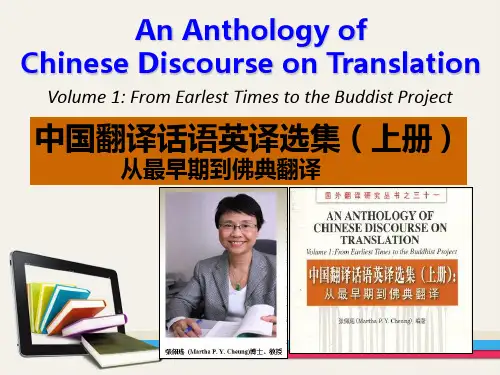
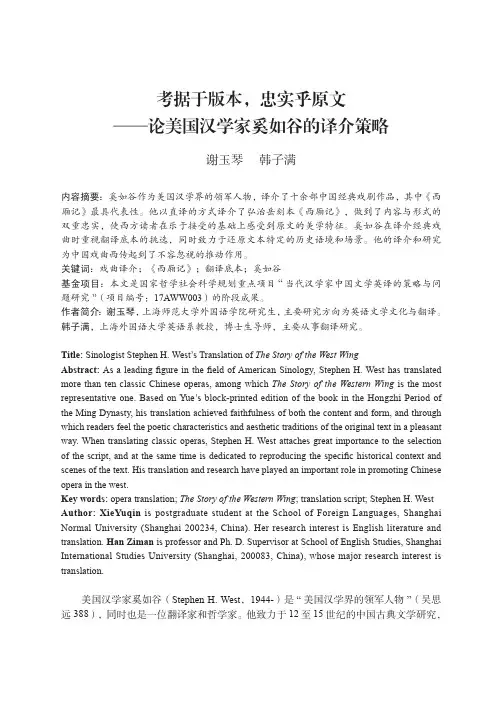
考据于版本,忠实乎原文——论美国汉学家奚如谷的译介策略谢玉琴韩子满内容摘要:奚如谷作为美国汉学界的领军人物,译介了十余部中国经典戏剧作品,其中《西厢记》最具代表性。
他以直译的方式译介了弘治岳刻本《西厢记》,做到了内容与形式的双重忠实,使西方读者在乐于接受的基础上感受到原文的美学特征。
奚如谷在译介经典戏曲时重视翻译底本的挑选,同时致力于还原文本特定的历史语境和场景。
他的译介和研究为中国戏曲西传起到了不容忽视的推动作用。
关键词:戏曲译介;《西厢记》;翻译底本;奚如谷基金项目:本文是国家哲学社会科学规划重点项目“当代汉学家中国文学英译的策略与问题研究”(项目编号:17AWW003)的阶段成果。
作者简介:谢玉琴,上海师范大学外国语学院研究生,主要研究方向为英语文学文化与翻译。
韩子满,上海外国语大学英语系教授,博士生导师,主要从事翻译研究。
Title: Sinologist Stephen H. West’s Translation of The Story of the West WingAbstract: As a leading figure in the field of American Sinology, Stephen H. West has translated more than ten classic Chinese operas, among which The Story of the Western Wing is the most representative one. Based on Yue’s block-printed edition of the book in the Hongzhi Period of the Ming Dynasty, his translation achieved faithfulness of both the content and form, and through which readers feel the poetic characteristics and aesthetic traditions of the original text in a pleasant way. When translating classic operas, Stephen H. West attaches great importance to the selection of the script, and at the same time is dedicated to reproducing the specific historical context and scenes of the text. His translation and research have played an important role in promoting Chinese opera in the west.Key words: opera translation; The Story of the Western Wing; translation script; Stephen H. West Author: XieYuqin is postgraduate student at the School of Foreign Languages, Shanghai Normal University (Shanghai 200234, China). Her research interest is English literature and translation. Han Ziman is professor and Ph. D. Supervisor at School of English Studies, Shanghai International Studies University (Shanghai, 200083, China), whose major research interest is translation.美国汉学家奚如谷(Stephen H. West,1944-)是“美国汉学界的领军人物”(吴思远 388),同时也是一位翻译家和哲学家。
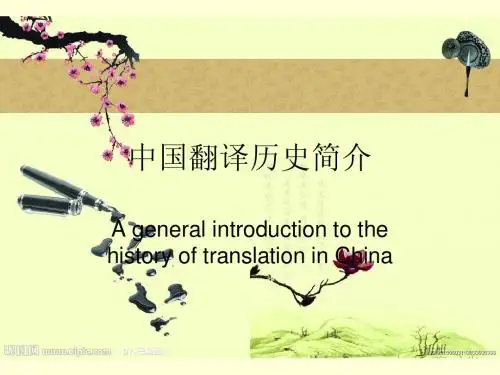
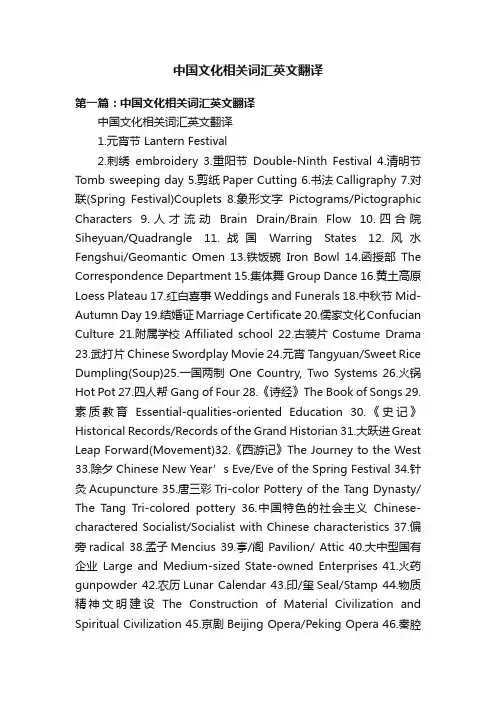
中国文化相关词汇英文翻译第一篇:中国文化相关词汇英文翻译中国文化相关词汇英文翻译1.元宵节 Lantern Festival2.刺绣embroidery3.重阳节Double-Ninth Festival4.清明节Tomb sweeping day5.剪纸Paper Cutting6.书法Calligraphy7.对联(Spring Festival)Couplets8.象形文字Pictograms/Pictographic Characters9.人才流动Brain Drain/Brain Flow 10.四合院Siheyuan/Quadrangle 11.战国Warring States 12.风水Fengshui/Geomantic Omen 13.铁饭碗Iron Bowl 14.函授部The Correspondence Department 15.集体舞Group Dance 16.黄土高原Loess Plateau 17.红白喜事Weddings and Funerals 18.中秋节Mid-Autumn Day 19.结婚证Marriage Certificate 20.儒家文化Confucian Culture 21.附属学校Affiliated school 22.古装片Costume Drama 23.武打片Chinese Swordplay Movie 24.元宵Tangyuan/Sweet Rice Dumpling(Soup)25.一国两制One Country, Two Systems 26.火锅Hot Pot 27.四人帮Gang of Four 28.《诗经》The Book of Songs 29.素质教育Essential-qualities-oriented Education 30.《史记》Historical Records/Records of the Grand Historian 31.大跃进Great Leap Forward(Movement)32.《西游记》The Journey to the West 33.除夕Chinese New Year’s Eve/Eve of the S pring Festival 34.针灸Acupuncture 35.唐三彩Tri-color Pottery of the Tang Dynasty/ The Tang Tri-colored pottery 36.中国特色的社会主义Chinese-charactered Socialist/Socialist with Chinese characteristics 37.偏旁radical 38.孟子Mencius 39.亭/阁 Pavilion/ Attic 40.大中型国有企业Large and Medium-sized State-owned Enterprises 41.火药gunpowder 42.农历Lunar Calendar 43.印/玺Seal/Stamp 44.物质精神文明建设The Construction of Material Civilization and Spiritual Civilization 45.京剧Beijing Opera/Peking Opera 46.秦腔Crying of Qin People/Qin Opera 47.太极拳Tai Chi 48.独生子女证The Certificate of One-child 49.天坛Altar of Heaven in Beijing 50.小吃摊Snack Bar/Snack Stand 51.红双喜Double Happiness 52.政治辅导员Political Counselor/School Counselor 53.春卷Spring Roll(s)54.莲藕Lotus Root 55.追星族Star Struck 56.故宫博物院The Palace Museum 57.相声Cross-talk/Comic Dialogue 58.下岗Lay off/Laid off 59.北京烤鸭Beijing Roast Duck 60.高等自学考试Self-taught Examination of Higher Education 61.烟花爆竹fireworks and firecracker 62.敦煌莫高窟Mogao Caves 63.电视小品TV Sketch/TV Skit 64.香港澳门同胞Compatriots from Hong Kong and Macao 65.文化大革命Cultural Revolution 66.长江中下游地区The Mid-low Reaches of Yangtze River 67.门当户对Perfect Match/Exact Match 68.《水浒》Water Margin/Outlaws of the Marsh 69.中外合资企业Joint Ventures 70.文房四宝笔墨纸砚“The Four Treasure of the Study” “Brush, Inkstick, Paper, and Inkstone” 71.兵马俑cotta Warriors/ Terracotta Army 72.旗袍cheongsam。
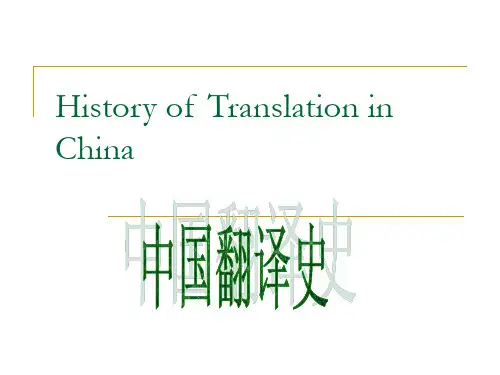
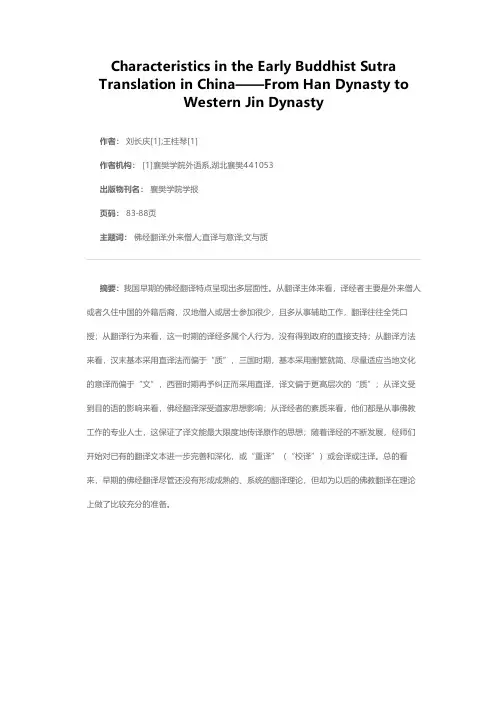
Characteristics in the Early Buddhist Sutra Translation in China——From Han Dynasty to
Western Jin Dynasty
作者: 刘长庆[1];王桂琴[1]
作者机构: [1]襄樊学院外语系,湖北襄樊441053
出版物刊名: 襄樊学院学报
页码: 83-88页
主题词: 佛经翻译;外来僧人;直译与意译;文与质
摘要:我国早期的佛经翻译特点呈现出多层面性。
从翻译主体来看,译经者主要是外来僧人或者久住中国的外籍后裔,汉地僧人或居士参加很少,且多从事辅助工作,翻译往往全凭口授;从翻译行为来看,这一时期的译经多属个人行为,没有得到政府的直接支持;从翻译方法来看,汉末基本采用直译法而偏于“质”,三国时期,基本采用删繁就简、尽量适应当地文化的意译而偏于“文”,西晋时期再予纠正而采用直译,译文偏于更高层次的“质”;从译文受到目的语的影响来看,佛经翻译深受道家思想影响;从译经者的素质来看,他们都是从事佛教工作的专业人士,这保证了译文能最大限度地传译原作的思想;随着译经的不断发展,经师们开始对已有的翻译文本进一步完善和深化,或“重译”(“校译”)或会译或注译。
总的看来,早期的佛经翻译尽管还没有形成成熟的、系统的翻译理论,但却为以后的佛教翻译在理论上做了比较充分的准备。
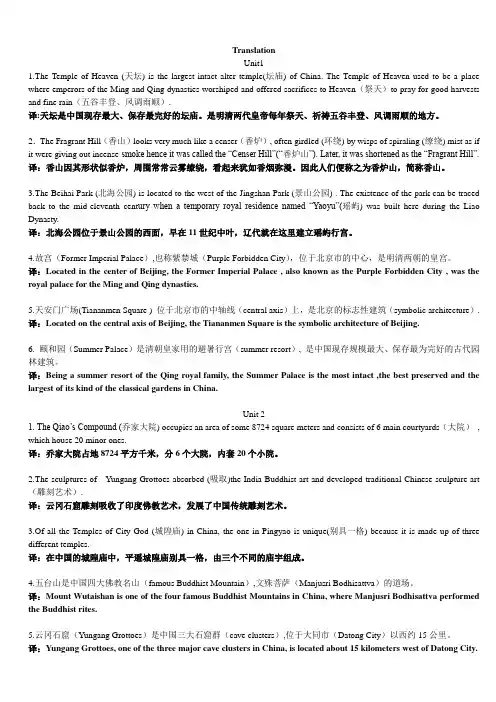
TranslationUnit11.The Temple of Heaven (天坛) is the largest intact alter temple(坛庙) of China. The Temple of Heaven used to be a place where emperors of the Ming and Qing dynasties worshiped and offered sacrifices to Heaven(祭天)to pray for good harvests and fine rain(五谷丰登、风调雨顺).译:天坛是中国现存最大、保存最完好的坛庙。
是明清两代皇帝每年祭天、祈祷五谷丰登、风调雨顺的地方。
2.The Fragrant Hill(香山)looks very much like a censer(香炉), often girdled (环绕) by wisps of spiraling (缭绕) mist as if it were giving out incense-smoke hence it was called the “Censer Hill”(“香炉山”). Later, it was shortened as the “Fragrant Hill”.译:香山因其形状似香炉,周围常常云雾缭绕,看起来犹如香烟弥漫。
因此人们便称之为香炉山,简称香山。
3.The Beihai Park (北海公园) is located to the west of the Jingshan Park (景山公园) . The existence of the park can be traced back to the mid-eleventh cent ury when a temporary royal residence named “Yaoyu”(瑶屿) was built here during the Liao Dynasty.译:北海公园位于景山公园的西面,早在11世纪中叶,辽代就在这里建立瑶屿行宫。
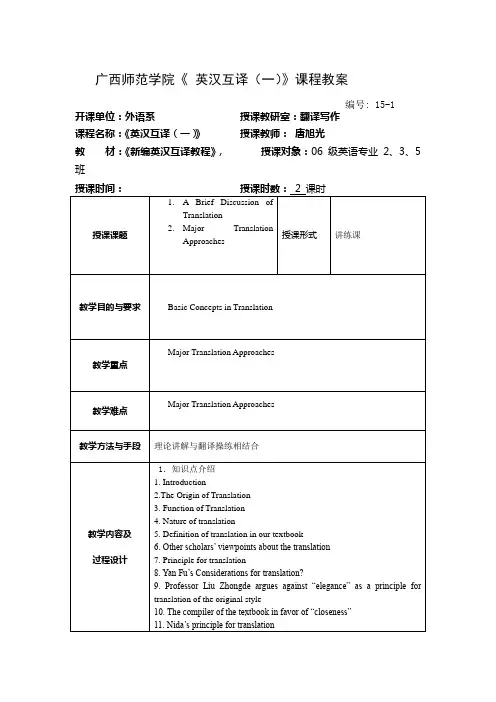
广西师范学院《英汉互译(一)》课程教案编号: 15-1 开课单位:外语系授课教研室:翻译写作课程名称:《英汉互译(一)》授课教师:唐旭光教材:《新编英汉互译教程》,授课对象:06级英语专业2、3、5班《英汉互译(一)》第一讲翻译简论与主要翻译方法(A Brief Discussion of Translation and Major Translation Approaches)1. IntroductionTranslation studies started along with translation practice. Translation theories developed flourishingly in the 20th century, especially in the second half of the last century.In fact, translation, which is a very complex phenomenon, is related to different disciplines, such as linguistics, psychology, sociology, cultural anthropology, communication theory, literary criticism, aesthetics, and semiotics. As translation study is a cross-discipline and cross-culture subject involving many aspects of human knowledge, the lack of a fully acceptable theory of translation should not come as a surprise. Meanwhile, quite a number of translation approaches and strategies have become universally acceptable and widely applicable. They are, of course, the fruits of many translation theorists and translation practitioners at home and abroad.2.The Origin of TranslationLanguage makes it possible for people to communicate with one another freely so as to complete important tasks in human life. Translation makes it possible for people from different languages to communicate with one another so as to complete important tasks in their life.Theodore Savory points out, “Translation is almost as old as original authorship and has a history as honorable and as complex as that of any other branch of literature”(申雨平, 2002:4).In Zhou Dynasty there were different forms of address for translators in different places. “Translators are called Ji in the east, Xiang in the south, Didi in the west, andYi in the north(东方曰寄,南方曰象,西方曰狄鞮,北方曰译)”(陈福康, 2000:3).3. Function of TranslationIt has helped people to better communicate with one another, and in the mean time it has facilitated the development of culture and civilization of all nations, such as the Sutra translation (佛经翻译)in China and the Bible translation in Western countries.Actually, translation, as a means to bridge different cultures, has been playing a very important role in promoting global economic and cultural development, and China in particular benefits a great deal from translation, which is obvious to all.4. Nature of translationOne school of theorists maintain that any interpretation is translation. Translation thus defined includes intra-lingual rewording(语言内的重新措辞), inter-lingual (语言之间的翻译或语际翻译)translation and inter-semiotic transmutation(符号转换).But most scholars who are interested in translation maintain that translation is a communicative activity which entails a most adequate or identical reproduction in a target language of a written message or text in a source language.5. Definition of translation in our textbook as follows: Translation or translating is a communicative activity or dynamic process in which the translator makes great effort to thoroughly comprehend a written message or text in the source language and works very hard to achieve an adequate or an almost identical reproduction in the target language version of the written source language message or text. In terms of its nature or character, translation is both an art and a science as well, since it calls for a good command of at least two languages, a flexible application of their rules, and some knowledge of at least two cultures, as well as a good grasp of the necessary translation theories.6. Other scholars’ viewpoints about the translation1). The traditional viewpoint about the nature of translation is that translation is an art only. This viewpoint is still maintained by Xu Yuanchong(许渊冲), a well-known professor at Beijing University, and a few other scholars.2). Professor Liu Zhongde vigorously advocates that translation is a science as well as an art mainly because of the following reasons:Firstly, like any other art and science, translation requires a good grasp and a flexible use of the necessary specialized knowledge and skills.Secondly, like any other art and science, translation calls for independent, honest and creative effort.Thirdly, just like any other art and science, translation demands that the translator be very careful about and highly responsible for his or her work.7. Principle for translationThe 13 statements on page 81). A translation must reproduce the words of the SLT(Source Language Text).2). A translation must reproduce the ideas (meaning) of the SLT.3). A translation should read like an original work.4). A translation should read like a translation.5). A translation should reflect the style of the original.6). A translation should possess the style of the translator.7). A translation should retain the historical stylistic dimension of the SLT.8). A translation should read as a contemporary piece of literature.9). A translation may add to or omit from the original.10). A translation may never add to or omit from the original.11). A translation should let the readers of the SLT and the target language text (TLT) have essentially the same response.12). A translation should convey what the SLT author intends to convey.13). A translation should satisfy the need of the client.Evidently, though each of the above statements is right in a certain sense, yet it is not adequate or comprehensive enough to serve as a translation principle. Some of the principles proposed by various translation theorists can find their expression in the statements given above. Interlinear translation is an illustration of the first statement. Yan Fu’s three-character principle can be a combination of statements 2, 3 and 6. Nida’s functional equivalence is best express ed in statement 11.8. Yan Fu’s Considerations for translation?Strictly speaking, a translation theory in its true sense in China originated from Yan Fu(严复). He proposed the famous triple principle for translation, namely, faithfulness(信), expressiveness(达) and elegance(雅).1). His faithfulness means that the translated text should be faithful to the original text, ie, the version should keep the content or ideas of the original.2). His expressiveness means that the translated text should be expressive and coherent without anything awkward. In other words, his expressiveness requires that the version should be fluid, smooth, and easy to read and understand.3). His elegance demands that the translated text should be exquisite and that its style ought to be very graceful.9. Professor Liu Zhongde argues against “elegance” as a principle for translation of the original styleHe argued eloquently against “elegance” as a principle for translation of the original style. We all know that not all works are characterized by the elegant style. Different writers display different styles. For instance, Lenin wrote in a bold style, and Hemingway wrote in a simple, symbolic style. Even the same writer shows different styles on different occasions for different purposes. Naturally, different works demonstrate different styles. Thus, it is impossible & absolutely wrong to achieve the effect of elegance in the translated text if the style of the original is not elegant.10. The compiler of the textbook in favor of “closeness”1). We are in favor of Professor Liu’s triple translation principle. He changed Yan Fu’s “elegance” into “closeness”, which represents his contribution to the translation theory. His “closeness” is central in meaning. It is suitable for translation of all types of texts with different styles.2). If the original text is characterized by the elegant style, the translator should do his utmost to render it into a graceful text in the target language whose style is close to the original elegant style.If the original style is highly technical with a wealth of technical terms, thetranslator ought to employ plenty of corresponding technical terms in the target language and make the translated style as close to the original technical style as possible.3). If the original style is colloquial with a lot of informal words and colloquial sentences, the translator should translate it into a text with an informal style as close as possible to the original one by using many colloquial words and informal sentences.If the original style is ornate, the translator should follow suit and make effort to render the translated style as close to the original as possible.If the original text contains some vulgar words and sentences, the translator is not entitled to replace them with elegant words or sentences, and he should reproduce the original by using some corresponding vulgar words and sentences in the receptor language. Translators are duty-bound to do so, for the simple reason that they are translators.4). As we know, Yan Fu’s triple translation principle is highly concise and well rhymed and quite easy to learn by heart, which is one of the reasons why it is still very popular in China today.Professor Liu’s triple principle is similar to Yan Fu’s in that it is equally concise and easy to remember.Though Professor Liu’s triple principle is n ot rhymed, yet it is very forceful and impressive, for the Chinese character “切” is uttered in the falling tone, carrying the implication that faithfully conveying the original style or rendering the translated style as close to the original as possible is absolutely necessary and worth the translator’s great effort.11. Nida’s principle for translationEugene A. Nida and Taber stated emphatically (1969:12): “Translation consists in reproducing in the receptor language the closest natural equivalence of the source language message, first in terms of meaning and secondly in terms of style”.His dynamic equivalence is defined as a translation principle, according to which the translator seeks to translate the meaning of the original in such a way that the target language text wording will produce the same impact on the target text audience as the original wording does upon the source text audience. Later on, Nida changed “dynamic equivalence” into “functional equivalence”, because it seemed much more satisfactory to use the expression “functional equivalence” in describing the degree of adequacy of a translation.12. The literal translation approachProfessor Liu Zhongde (1994: 172) defines literal translation as follows: “In the process of translation, literal translation treats sentences as basic units and at the same time takes the whole passage into consideration; a translator who attaches great importance to literal translation does his or her best to reproduce the ideas and writing style of the original work, retaining in the version as many rhetorical devices and sentence structures of the original as possible.”ExamplesHe is said to be a rough diamond.人们说他是一块浑金璞玉。
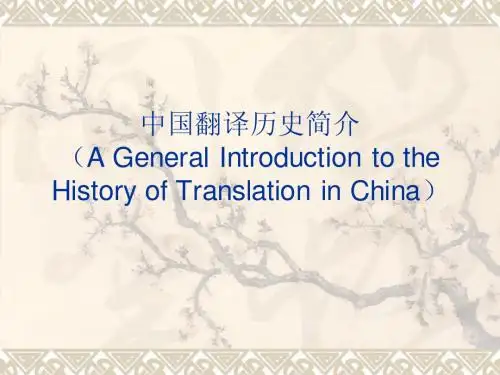
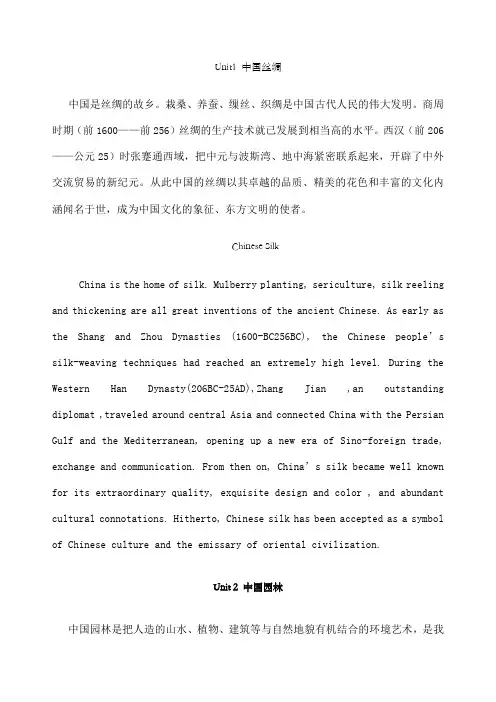
Unit1 中国丝绸中国是丝绸的故乡。
栽桑、养蚕、缫丝、织绸是中国古代人民的伟大发明。
商周时期(前1600——前256)丝绸的生产技术就已发展到相当高的水平。
西汉(前206——公元25)时张蹇通西域,把中元与波斯湾、地中海紧密联系起来,开辟了中外交流贸易的新纪元。
从此中国的丝绸以其卓越的品质、精美的花色和丰富的文化内涵闻名于世,成为中国文化的象征、东方文明的使者。
Chinese SilkChina is the home of silk. Mulberry planting, sericulture, silk reeling and thickening are all great inventions of the ancient Chinese. As early as the Shang and Zhou Dynasties (1600-BC256BC), the Chinese people’s silk-weaving techniques had reached an extremely high level. During the Western Han Dynasty(206BC-25AD),Zhang Jian ,an outstanding diplomat ,traveled around central Asia and connected China with the Persian Gulf and the Mediterranean, opening up a new era of Sino-foreign trade, exchange and communication. From then on, China’s silk became well known for its extraordinary quality, exquisite design and color , and abundant cultural connotations. Hitherto, Chinese silk has been accepted as a symbol of Chinese culture and the emissary of oriental civilization.Unit 2 中国园林中国园林是把人造的山水、植物、建筑等与自然地貌有机结合的环境艺术,是我国古代建筑艺术的珍宝。
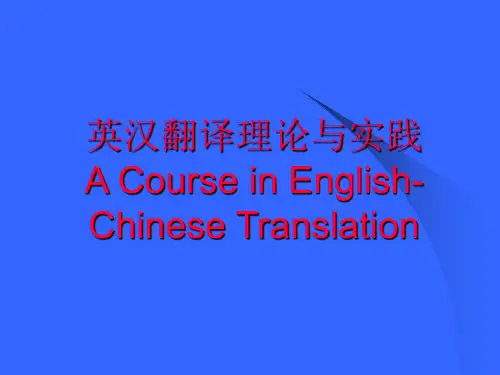
中国,这个古老而神秘的东方古国,曾对东西方文明的发展产生过深远的影响,她的名字也因此而充满了神秘的色彩。
域外对中国的称呼或译名有多种,其中有些至今尚无定论。
通过对这些名称的历史回顾及考察,我们可以从其来源和演变过程中看出中外民族交往及文化交发展变化的一些轨迹,从而更加深刻地了解中国在人类文明的进程中所占的重要地位。
下面来回顾一下这些译称中提及最多的三种。
一、Seres(丝国)早在中国瓷器传入西方之前,丝绸就已自商代开始西传。
《尚书·酒诰》云:“肇牵车牛,远服贾”。
《管子·轻重》中亦有殷王倡导丝绸外贸之记载。
专家们从古希腊雕塑及绘画作品中展现的细薄衣料画面,推测中国丝绸在春秋时代已达希腊。
汉代随着丝绸之路的开通,中国丝绸曾大量远销罗马、英伦,风靡西方。
那时,西方人相信丝是从树上长出来的。
公元一世纪罗马作家普林尼在其所著的《博物志》中,依据想象把中国描绘成一个遍地丝绸的锦绣之国。
西方史书还记载有罗马凯撒大帝酷爱中国的丝绸服装,罗马帝国为此不惜将国库掏空的史实。
最早用Seres一词指称“中国”的是曾于公元前416-398年间任波斯宫廷医生的古希腊人克泰西阿斯(Ctesias)。
古罗马诗人弗吉尔的诗句“中国人把他们羊毛的树林纺成细纱”,就用Seres来指称中国人。
古代英国人也把丝叫做“中国羊毛”(Seres’wool)。
语言学家们进而考证出印欧语里及许多其他民族语言里表示“丝”意的读音,如:拉丁语sericum,sericus,古斯堪的纳维亚语Silki,盎格鲁撒克逊语Seolc,古英语Selk,俄语shelk’,以及蒙古语、波斯语、阿拉伯语中该词的读音也都跟汉语“丝”有关。
中国出口了丝,随之也把“丝”这个字的含义和读音带到了国外,并由此获得了对“中国”的最早译名Seres(丝绸之国)。
二、China(秦国)英语中“中国”和“瓷器”是同一个词,仅第一个字母C有大小写之分,即China和china,可理解为:中国,瓷器之国也。
玄奘对我国翻译的历史贡献江玉菡2008级2班20080510873摘要:玄奘是我国杰出的佛经翻译家,他翻译了大量佛经,是“新译”的创始人。
他提出的著名的“五不翻”原则及“既须求真,又须喻俗”的标准,对我国翻译事业有很大影响。
关键词:玄奘,佛经,翻译,影响Abstract:Xuanzang is an outstanding Chinese Buddhist translator. He translated a number of Scriptures, and he is the “founder of the new translation”. His famous theory of “The Five Kinds of Terms Not Translated”and his standard that “A good translation should be both faithful to the original and intelligible to the public”have a great impact on the interpretation of China.Key words: Xuanzang,Buddhist sutra,translation,influence引言玄奘(602年-664年),唐朝著名的“三藏法师”,与鸠摩罗什、真谛并称为中国佛教三大翻译家。
出家后遍访佛教名师,因感各派学说分歧,决心西行求法以释疑惑,往返17年,行程5万里,携回梵文经典650余部,是中印文化交流的使者。
回国后组织译经,译出经纶75部,1335卷,且译经质量,前所未有,所译之经被称为“新译”。
1.佛经“新译”的创世人我国佛经汉译从东汉时期就开始了,而时至唐朝,进入了全盛时期。
而唐代的翻译事业之所以这么繁荣,又要归功于这位“新译”的创人玄奘。
译经家把玄奘以前所译的经典称为“旧译”,自玄奘之后所译的经典称为“新译”。
玄奘对我国翻译的历史贡献江玉菡2008级2班20080510873摘要:玄奘是我国杰出的佛经翻译家,他翻译了大量佛经,是“新译”的创始人。
他提出的著名的“五不翻”原则及“既须求真,又须喻俗”的标准,对我国翻译事业有很大影响。
关键词:玄奘,佛经,翻译,影响Abstract:Xuanzang is an outstanding Chinese Buddhist translator. He translated a number of Scriptures, and he is the “founder of the new translation”. His famous theory of “The Five Kinds of Terms Not Translated”and his standard that “A good translation should be both faithful to the original and intelligible to the public”have a great impact on the interpretation of China.Key words: Xuanzang,Buddhist sutra,translation,influence引言玄奘(602年-664年),唐朝著名的“三藏法师”,与鸠摩罗什、真谛并称为中国佛教三大翻译家。
出家后遍访佛教名师,因感各派学说分歧,决心西行求法以释疑惑,往返17年,行程5万里,携回梵文经典650余部,是中印文化交流的使者。
回国后组织译经,译出经纶75部,1335卷,且译经质量,前所未有,所译之经被称为“新译”。
1.佛经“新译”的创世人我国佛经汉译从东汉时期就开始了,而时至唐朝,进入了全盛时期。
而唐代的翻译事业之所以这么繁荣,又要归功于这位“新译”的创人玄奘。
译经家把玄奘以前所译的经典称为“旧译”,自玄奘之后所译的经典称为“新译”。
A History of the Chinese Translation1.1 The earliest translation in ChinaThe convincing historical record of the earliest translation activities in China can be found in the Zhou Dynasty(周代) about 3000 years ago.In the books《周礼》and 《礼记》,the record of the title of the translator is kept. The title of the earliest translator is called 象胥。
1.2 Translation in the Han DynastyGenerally speaking, translation in Han Dynasty is mainly focused on that of Buddhist sutras.Ma Zuyi‘s Division of Sutra Translation in ChinaAccording to Ma Zuyi, from the Han Dynasties to the Western Jin(A.D.148-316) is a period of starting the translation of the Buddhist scriptures. In fact, the enormous introduction of the Buddhist scriptures into China began in the Eastern Han Dynasty (A.D.148) and the earliest translators are 安清and支娄迦谶. Besides, there are other translators such as 安玄, 严佛调, 朱士行,支谦,康僧会and 竺法护.Characteristics of the translation in this time(公元148-316):A. Translation of the Buddhist scriptures is done for the purpose of meeting the needs of the then society. Although the then society simply regarded Buddhism as a kind of superstition, some preachers or missionaries took great interest in introducing it to the Chinese people. At the end of the Eastern Han Dynasty, the class contradictions became sharper and as a result there broke out an enormous peasants uprising of Huangjin. During this period of time Buddhism spread more quickly than ever as it could be used by different people for different purposes.B.―质朴‖和―文丽‖两派争论。
五分钟兵马俑英语讲解词以下是一份五分钟兵马俑英语讲解词及中文意思:女士们、先生们,欢迎来到中国古都西安,今天我将带大家领略一处世界闻名的历史遗迹——兵马俑。
兵马俑是中国古代秦始皇陵的一部分,位于今天的陕西省西安市。
这些兵马俑是秦始皇统一中国后为了保卫他的帝国而建造的,武士俑可能有 7000 件,每一个兵马俑都栩栩如生,根据军队的编制和职务进行精细雕刻,向我们展现了古代的战争艺术。
兵马俑的发现被认为是二十世纪最重要的考古发现之一,它们不仅是中国古代文明的杰作,也是世界文化遗产的瑰宝。
让我们一同踏上时光之旅,在这片土地上领略中国古代帝王的伟大与辉煌。
Ladies and gentlemen, welcome to the ancient capital of China, Xi'an. Today, I will take you to a world-famous historical site - the Terracotta Army.The Terracotta Army is a part of the Mausoleum of the First Qin Emperor in ancient China, located in Xi'an, Shaanxi Province today. These Terracotta Warriors were built by the First Emperor of Qin to protect his empire after he unified China. There may be 7,000 warrior statues, each one lifelike, carefully carved according to the organization and duties of the army, showing us the art of ancient warfare.The discovery of the Terracotta Army is considered one of the most important archaeological discoveries of the 20th century. They are not only a masterpiece of ancient Chinese civilization, but also a gem of world cultural heritage.Let us embark on a journey through time and experience the greatness and glory of the ancient Chinese emperors on this land.。
蜀绣(Sichuan Embroidery)
蜀绣作为流传两千余年的古代手工艺品源于中国四川省(俗称“天府之国”)。
从古至今,四川省山川秀美、物产丰富。
蜀绣与苏绣、湘绣、粤绣并称为中国四大名绣。
蜀绣因其明艳细致的用色及中国水墨画构图被誉为“东方艺术瑰宝”。
四川省古时盛产丝绸,成都即为“南方丝绸之路”的起点。
另,中国古代杰出的画家为蜀绣的发展提供了丰富的素材,如郑板桥的竹、石以及苏东坡的怪石。
蜀绣民间常用于被套、枕套等日用品,也用以制作画屏以供观赏。
然而,鉴于其多变复杂的缝制方法、精湛高超的制作技巧及其美轮美奂的图案,人们很难将如此精美的工艺品作为日常使用。
“既生瑜, 何生亮?”
周瑜:中国古代军事家,在中国历史及文学作品中以赤壁拒曹而知名。
《三国演绎》描述了他嫉妒对手诸葛亮的性格特点。
在罗贯中的历史小说《三国演绎》中,周瑜与诸葛亮在战争中展开竞争。
他极为妒忌诸葛亮的才能并且拼命试图在才智上超越对手,但每每遭遇失败。
小说中他的形象往往因诸葛亮的出现而变的暗淡,特别是在赤壁之战中。
此外,小说将周瑜之死戏剧化的改编为由诸葛亮故意气死。
周瑜在江陵之战中所受箭伤因气愤诸葛亮三次破坏了他的计划而不断恶化。
“三气周瑜”之后,他咳血并长叹道:“既生瑜,何生亮”,随即倒毙身亡。
中国古代的翻译工作概述一、中国古代的翻译工作中国历朝历代都有专人从事翻译工作,远在商周时期就有人开始做类似工作。
香港《文汇报》今日刊发署名“王东峰”的文章,对中国古代的翻译工作进行了梳理。
文章中称,中国是一个多民族国家,自古以来,又与其它国家保持外交关系和友好往来。
民族相异,国家不同,语言和文字就千差万别,因此,历朝历代都设有专人专职或专门机构从事翻译工作。
仅就官职而言,周代有“寄”、“像”、“译”等;秦汉时期有“九译令”、“译官令”、“译官丞”;南北朝有“译令史”;隋唐时期置“通事舍人”;宋辽金时期分别有“润文史”、“译史”、“通事”;元朝设“怯里马赤(蒙古语,指口语翻译)”;明朝有“译字生”;清朝设“通译官”。
这些翻译人员的级别不高,一些朝代的翻译人员甚至没有品级。
清代的通译官一般为七、八品,光绪年间,各使馆的头等通译官始提高待遇,定为正五品,限额一名,严禁超编。
古代的翻译工作远在商周时期就开始进行了。
据西汉伏胜《尚书大传》载:交趾之南有越裳国,“周公居摄六年,制礼作乐,天下和平;越裳以三象重译而献白雉,曰:…道路悠远,山川阻深,音使不通,故重译而朝‟”。
“像”是翻译官,“重译”就是多次翻译的意思,越裳国包括今越南大部和柬埔寨部分地区,与中国相距遥远,言语不通,所以需要翻译成汉文才能看懂。
从史料记载来看,从南北朝至唐代,官方的翻译机构和译员主要从事佛经的翻译工作。
南朝梁惠皎《高僧传.佛陀什》云:“先沙门法显于师子国(今斯里兰卡)得《弥沙塞律》梵本。
未被翻译而法显迁化。
京邑诸僧闻什既善此学,于是请令出焉,以其年冬十一月集于龙光寺,译为三十四卷,称为《五分律》。
”另外比较著名的,就是唐代高僧玄奘法师,他从印度带回大小乘佛教经典520夹、657部。
回到长安后,住大慈恩寺,专心译经,前后共翻译佛经1300多卷,同时,将《老子》等中文经籍译成梵文,传入印度。
宋辽金时期,为了适应对敌国斗争的需要,在生员考试中增加了翻译女真文、契丹文和西夏文的内容。
而西夏、辽和金国,为了吸收中原地区的先进文化,特别重视翻译工作。
西夏仁宗时,专门设立“刻字司”,翻译《孙子兵法》、《六韬》、《贞观政要》等大量汉文典籍。
辽国则在州以上行政机关设立专门的译文机构。
为了激励译员的工作积极性,辽道宗下诏制定了译史的升迁等级,按照供职时间长短和工作水平的高低决定其是否升职。
金世宗下令成立译经所,先后将《孝经》、《易》、《书》、《论语》、《孟子》等汉文典籍译成女真文。
元代疆域广阔,民族众多,先后设立了“蒙古房”、“蒙古官学、唐古特学及托忒学”等官署,培养熟谙蒙文、藏文、托忒文的专门人才,并负责翻译蒙、回、藏文书籍。
明朝初年,为了了解元朝的情况,朱元璋命翰林院侍讲火原杰、编修马沙亦黑等人编撰《华夷译语》,以汉文解释蒙古文。
明成祖永乐五年,在京城设立“四夷馆”,内分蒙古、女真、西蕃(西藏)、西天(印度)、回回、百夷(傣族)、高昌(维吾尔)、缅甸八馆,“置译字生、通事,通译语言文字”。
明神宗时,又增设暹罗馆(泰国)。
清初,四夷馆更名为“四译馆”,减去女真、蒙古两馆。
乾隆时,这一机构又与专门接待少数民族官员和外国使臣的“会同馆”合并,改名为“会同四译馆”,分设西域、八夷两馆,直到光绪二十五年(1899)废止。
Sutra Translation in Ancient China (1)I. General IntroductionA vast country with scores of regional languages, China has probably witnessed translation and interpreting activities since the first tribal battle or produce-exchange. Early historical works such as the first century BC Records of the Grand Historian contain many references to translation in the context of diplomacy and commerce. As early as the Zhou Dynasty, in the ninth century BC, there were special government officials in charge of interpreting and translation work; their titles varied according to the group of languages they covered. An integral part of protocol, they were always present at meetings with foreign emissaries. The term for a government interpreter of this period was sheren, literally …tongues-man‟. The current Chinese word for …translation‟, yi, forms the basis for the official title adopted since the Han Dynasty: yiguan and yishi, literally …translation official‟. Historical records also show that during the Dan dynasty, translators/interpreters (yizhang) were routinely employed by merchants on their long trips to South-East Asia and India; they were also present in the merchant caravans bound for states such as Bactria to the north-west of China. During the Tang Dynasty, a period in which cultural exchanges between China and her neighbouring states reached new heights, a considerable number of foreigners who lived in China were employed as government interpreters and were allowed to accompany Chinese officials on diplomatic missions.In the 3,000 years from the Zhou dynasty to the present, the bread-and –butter of the Chinese translator‟s work has always been in government and commerce. There are extant poetry translations dating back to at least the fourth century BC, but these early literary translations were mostly recorded as part of the experience of various diplomatic missions. There have been periods, however, when t ranslation played a crucial role in China‟s cultural and social development, going far beyond the confines of government and commerce. The most significant of these periods relate to the translation of Buddhist scriptures, the work of Christian missionaries, the political and cultural events leading to the May fourth Movement, and the emergence of the People‟s Republic of China and subsequent contact with European countries. But translation and interpreting have also had a role to play in China outside of such peak periods and, apart from the major languages involved in those periods, a significant number of Chinese books have been translated from the eleventh century onwards into such languages as Mongolian, Western Xia, Manchurian andJapanese.附录:1.《越人歌》原载西汉刘向(约公元前77年至前6年)著的《说苑》一书中的《善说》篇里.《善说》记述着春秋时代楚令尹鄂君子晰在游船上赞赏榜枻越人唱歌的生动故事。
作者刘向在文中通过楚大夫庄辛之口,描绘了这场富丽豪华的舟游盛况之后,紧接着这样写道:“会钟鼓之音毕,榜枻越人拥楫而歌,歌辞曰:…滥兮抃草滥予?昌桓泽予?昌州州湛。
州焉乎秦胥胥,缦予乎昭澶秦逾渗。
惿随河湖‟。
鄂君子晰曰:…吾不知越歌,子试为我楚说之‟。
于是乃召越译。
乃楚说之曰:…今夕何夕兮?寨洲中流。
今日何日兮?得与王子同舟。
蒙羞被好兮,不訾诟耻。
心几顽而不绝兮,得知王子。
山有林木兮木有枝。
心悦君兮君不知。
‟于是鄂君晰乃#修袂行而拥之,举绣被而复之。
”Song of the Yue今夕何夕兮。
搴舟中流。
今日何日兮。
得与王子同舟。
(蒙羞被好兮,不訾诟耻。